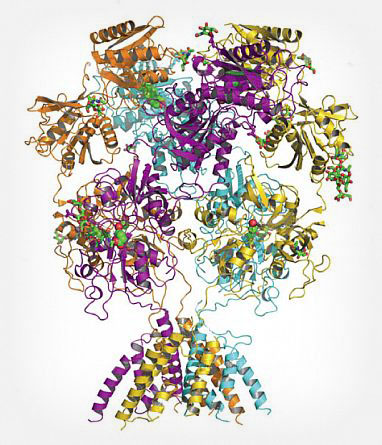Neuronal Building Block Underlies Alcohol Addiction

Scientists believe repeated alcohol consumption can lead to alcohol dependence by altering the NMDA receptor (pictured above). Supporting this idea, new NIH research was able to prevent alcohol dependence in mice by genetically deleting a specific portion of the receptor.
While many people can easily stop after a beer or two, for others one drink begets many more, ultimately leading to an addiction that drives continuously increasing alcohol consumption over time. New IRP research has identified a specific type of neuronal receptor involved in the development of alcohol dependence in mice, suggesting a possible approach to curbing problematic drinking behaviors in humans addicted to alcohol.1
Like fitting a key into a lock opens a door, when alcohol enters the brain, it activates certain neurons by binding to structures on them called NMDA receptors. And just as opening and shutting a door thousands of times can slowly warp its hinges, repeatedly exposing NMDA receptors to alcohol can change how they work. Many scientists believe that these alterations contribute to the behavioral changes that chronic alcohol use can cause, such as how alcohol dependence drives some drinkers to consume more and more over time.
NMDA receptors are made up of combinations of different building blocks, or subunits. Until recently, little was known about which specific subunit allowed alcohol to alter the functioning of NMDA receptors, but past research led by IRP senior investigator Andrew Holmes, Ph.D., suggested that a subunit called NR2A might play an important role.2
“There’s long been interest in targeting the NMDA receptors as a treatment for alcohol use disorders,” says Dr. Holmes, the new study’s senior author. “But because it’s such an important receptor in the brain, directly targeting the receptor complex as a whole would not be a good strategy in terms of attaining a clean benefit without side effects.” If additional research could confirm the importance of the NR2A subunit to alcohol-induced behavioral changes, it might be possible to create drugs that affect only NMDA receptors containing that subunit, thereby reducing side effects.
To that end, Dr. Holmes’ team set out to investigate whether mice genetically manipulated to lack the NR2A subunit throughout their brains would behave differently from genetically normal mice after repeated exposure to high doses of alcohol. When given a choice between drinking water and a solution with an alcohol concentration similar to a fortified wine, typical mice that had been chronically exposed to alcohol drank much more of the alcohol solution than before they were exposed to alcohol, a sign that they had become dependent on the drug. However, mice lacking the NR2A subunit in their NMDA receptors did not show this behavioral change.
Dr. Holmes’ team also collaborated with researchers at the UNC Chapel Hill School of Medicine to search for differences in the electrical activity of neurons from the NR2A-lacking mice compared to the genetically normal mice, but they ultimately could not find any. Dr. Holmes says this may be because they only examined neurons from one brain region, albeit one that has previously been linked to alcohol-induced behavioral changes, and it may be that other brain areas are driving the drinking behaviors observed in the behavioral experiments. Future studies that remove the NR2A subunit from only one part of the brain, rather than the entire brain, might be able to pinpoint the exact set of neurons involved in the development of alcohol dependence.
Nevertheless, Dr. Holmes says, the study provides compelling evidence that the NR2A subunit of NMDA receptors plays an important role in alcohol dependence. It also builds on human studies that show that variations in the GRIN2A gene, which provides instructions for creating the NR2A subunit, are linked to differences in the risk for alcohol addiction.3
“It’s really exciting to me that our findings converge with studies in humans, which is not always the case in basic research,” Dr. Holmes explains. “It strongly suggests that there’s something important going on here because this subunit is playing a significant role across species.”
The agreement between human genetic studies and Dr. Holmes’ mouse experiments presents the possibility that sequencing a patient’s GRIN2A gene could one day yield information about his or her risk for alcohol addiction. Further down the line, the invention of drugs that specifically inhibit NMDA receptors containing the NR2A subunit could reduce susceptible individuals’ dependence on alcohol.
“I would be very excited if this research led in that direction,” Dr. Holmes says. “It’s great when you start to think about how basic science findings like these might translate to therapies.”
Subscribe to our weekly newsletter to stay up-to-date on the latest breakthroughs in the NIH Intramural Research Program.
References:
[1] NMDA receptor GluN2A subunit deletion protects against dependence-like ethanol drinking. Jury NJ, Radke AK, Pati D, Kocharian A, Mishina M, Kash TL, Holmes A. Behav Brain Res. 2018 Jun 25. pii: S0166-4328(17)31649-2. doi: 10.1016/j.bbr.2018.06.029.
[2] Tolerance to ethanol intoxication after chronic ethanol: role of GluN2A and PSD-95. Daut RA, Busch EF, Ihne J, Fisher D, Mishina M, Grant SG, Camp M, Holmes A. Addict Biol. 2015 Mar;20(2):259-62. doi: 10.1111/adb.12110.
[3] Association between a polymorphism in the promoter of a glutamate receptor subunit gene (GRIN2A) and alcoholism. Domart MC, Benyamina A, Lemoine A, Bourgain C, Blecha L, Debuire B, Reynaud M, Saffroy R. Addict Biol. 2012 Jul;17(4):783-5. doi: 10.1111/j.1369-1600.2011.00321.x.
Related Blog Posts
This page was last updated on Tuesday, January 30, 2024
